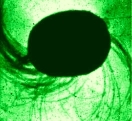Theoretical developments

Generally speaking, I'm interested in distributed models of life and cognition. In other words, I try to understand and simulate how life and cognition may emerge from processes in interaction. Main sources of inspiration include the Interactivist framework (Bickhard), Piagetian constructivism (Piaget) and the Enactive paradigm (Varela, Thompson).
My convictions about the emergent and interactive nature of cognition are grounded in scientifically sound theories dealing with far-from-equilibrium systems (Prigogine) and the evolution of self-maintaining systems. Obviously, these developments commit to the hypothesis of a deep continuity between the physical world, life and mind. Pages about such transitions from general dynamical systems to bacteria to humans are available here.
Working in such a general framework requires finding a minimal set of principles necessary to explain phenomena or behaviors without dwelling on details specific to a particular situation or species. This is however not contradictory with the fact that each species or each individual subject is unique and that beauty also is in the details. The goal here is to look for simplicity and avoid simpleness. Principles found again and again at different scales and periods include regulation/modulation or synchronization/anticipation that helped various forms of life to keep being adapted when growing bigger (plants, animals) or when crossing the social divide (multicellular life, insect colonies, societies).
Computational developments

In practice, after reading papers in diverse fields (such as biology or philosophy), principles and ideas are translated into computational models to simulate the dynamics of minimalistic forms of life or sensorimotor agents (that cannot seriously be called cognitive with regards to human standards). Although generally working in artificial intelligence or computational neuroscience labs, my research project is thus more likely to be affiliated with the general field of cognitive science. My will is to go back and forth between life sciences and computer science as to enrich and benefit from the different perspectives.
The goals of my research are therefore twofold:
- Producing efficient and robust systems with applications to robotics and computer science. In this domain, my work focuses on sensorimotor interactions with (or between) humans and robots.
- Testing and refining the theory, as models only reflect the designer ideas and cannot be used as proofs, but can easily refute hypotheses or point to limitations.
The computational models on which I work can be artificially divided in two categories:
- Minimal agency, where starting from various definitions of agency, I try to understand the conditions and implications of developing artificial agents. I also try to relate the different concepts involved in the definitions with the above-mentioned principles, as to estimate their range of validity. Barandiaran et al. proposed for instance in 2009 that agents might be characterized by autonomy, interactional asymmetry and normativity, thus going beyond the non regulative autopoiesis (by introducing implicit forms of anticipation and regulation, at least from my perspective).
- Sensorimotor behaviors, emerging from the interactions of active processes, that locally predict the sensorimotor dynamics (some kind of Piaget's schemas). Each process continuously tries to assimilate some aspects of the current situation and to influence the agent's actions. Learning and forgetting abilities are also required and implemented when dealing with complex and changing environments (whether simulated or real). This leads to an open-ended process where stable closed networks of interactions/predictions may define objects and basic concepts (in the sense of O'Regan).
These models all share the very same principles, although sometimes implemented differently. In any case, the interactions between the many processes defining the system lead to two opposite yet complementary phenomena:
- Competition, which is required to focus on a stimulus in a rich environment, as well as to take decisions and actions (when different choices/behaviors are possible).
- Coordination, which is needed as soon as reaching a goal requires going through local extrema (in time), or when various behaviors are simulatenously effective and interdependent (in space).
My initial Master and doctorate theses, as well as my ongoing background research are focused on developing a sensorimotor architecture able to account for the flexibility and normativity of behaviors. A sketch and the up to date results of the proposed architecture, also relating it to other proposal and dominent paradigms are presented on the dedicated architecture pages. It has been applied to robust recognition and tracking of rhythms, visual perception in noisy environments as well as dynamic planning and goal reaching.
Technical developments

The implemented systems are massively parallel, and simulating them on current computer architectures requires some optimization. Indeed, the goal here is not to run them as fast as possible since delays can be easily integrated in the predictions, but simply to guarantee real time performance, as it is necessary to interact with the real world.
Optimization can then take two forms:
- Hardware optimization, adopting for instance a GPGPU stance to take advantage of the huge computational power of modern graphics cards. This is very beneficial when dealing with the raw sensory flow and a myriad of similar processes assimilating it (for instance to simulate the cortical visual areas working on the optic flow). However dedicated architectures such as the Cell-BE, FPGAs or even grid computing may better fit the needs when dealing with heterogeneity.
- Software optimization, as the ideal parallel behavior can be efficiently approximated by carefully designed algorithms. When processes follow a given topology, integration and interpolation of activity can be reduced to nearby elements, the problem with complex and often chaotic systems being to define what near should mean. In the case of sensorimotor interactions, an adequate metrics is hard to define and we must rely on weaker notions of similarity.